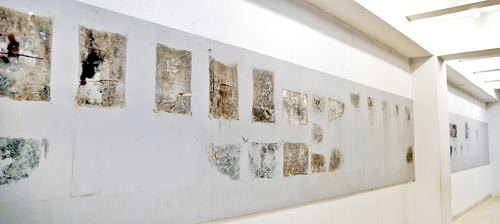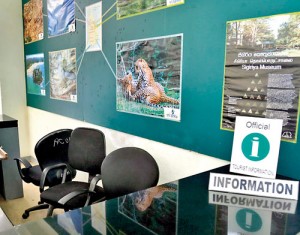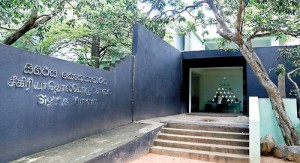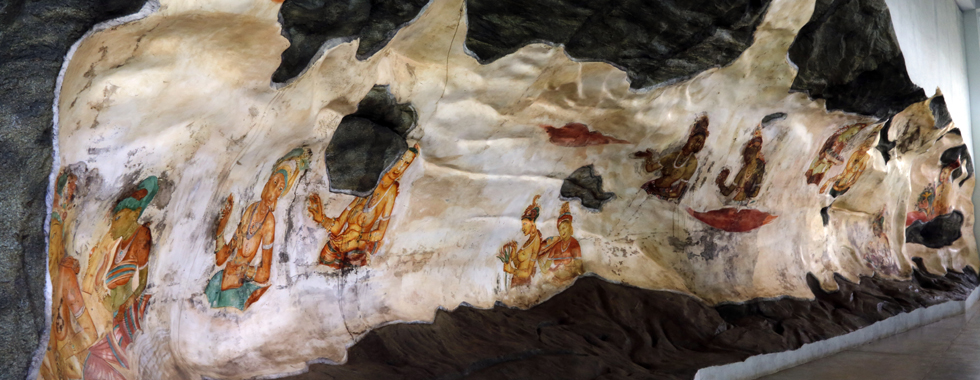News
Just 6 years on and Sigiriya museum already gone to the monkeys
Run down and desolate, it is pleading for attention.

The blank wall with non-exhibit ugly frame-like blotches staring the visitor in the face. Pix by M.A. Pushpa kumara
The state-of-the-art Sigiriya Museum and Information Centre, with the majestic rock fortress, a UNESCO World Heritage Site as its backdrop, is in a bad state. Just six years down the line, it is a poor shadow of what it was when it was opened with much pomp and pageantry in 2009 under the management of the Central Cultural Fund (CCF).
It is on Wednesday that the Sunday Times team enters what the CCF website still boasts of as “the museum in Sigiriya known to be the ‘most attractive’ in South Asia”. The Sigiriya Museum and Information Centre was funded by Japan through JICA under its Project for the Development of Culture-oriented Tourism which hopes to promote nature-culture-traditional lives.
Having purchased two Rs. 50 tickets, we turn right from the ticket booth to walk to the museum, while many foreigners and locals simply ignore the tree-shaded pathway leading to the museum and head for the Sigiriya rock, oblivious that there is a fount of information at the museum.
From entry to exit, although the CCF grandly states that the “museum represents its (Sigiriya’s) cultural, technological and archaeological value” and that “three decades of archaeological research on this site can be explored here”, there is only a feeling of despondency as we wonder through the building.
The Information Desk is unmanned and we hand over our tickets to a person at a counter at the bottom of the stairway, before heading upstairs to

An unmanned information desk
TVs which get activated when visitors get close and begin telecasting the history of Sigiriya. To the left, along the wall are well-displayed stamps and currency notes issued in celebration of Sigiriya.
Beyond, however, there is only a blank wall with non-exhibit ugly frame-like blotches staring the visitor in the face.
All over the building, the design of which is touted to be inspired by the sophisticated design of Sigiriya itself and following the concept of a Green Building with the mastery use of water and the use of trees so that it stimulates a true experience, there is only dirty and fungus-pocked walls, animal excreta on the floors and a depressing feeling of being unkempt.
There certainly is no feeling, even though reiterated by the CCF website of a climb-up majestic Sigiriya, which the museum attempts to emulate through ascending terraces and wide stairways.
Onto the right on the first floor, a brick tunnel, designed similarly to the archway of the Sigiriya fortress, leads to a gallery of exhibits of artefacts such as a human skeleton, tools, jewels, sculptures et al found through archaeological excavations. Yes, the galleries are well-displayed with drawings, photographs and information, with the pieces de resistance being the partially-conserved original furnace used for steel-making with tuyeres brought from a vast iron-smelting site of yore at Alakolawewa and the replica (the original is at the National Museum in Colombo) of the intriguing intricately-carved single ear-ornament believed to have been worn by a Sigiriya maiden.
However, as soon as we enter the gallery we are assailed by a gentle, not-too-overbearing odour of mustiness reminiscent of decay. Later we learn that the air-conditioners are not working and even after being repaired on numerous occasions are still malfunctioning. This is also where the

Most visitors ignore this entrance to the much-touted museum and head for the rock
centerpiece of the museum lies – the glass-topped model of Sigiriya with water gardens and all, providing a bird’s eye view of its grandeur.
Even the passage along the authentic imitation of the fresco-pocket — which had been turned out in Japan, brought down to Sigiriya and carefully-assembled like a giant jigsaw puzzle — is strewn with excreta, exuding an air of neglect. Naturally-landscaped to blend with the environment and built on the Yan Oya, Sigiriya’s marvellous bubble fountain which too has been replicated here lies moss covered and dirty, sans the water.
Not so long ago in 2012, this was the museum which had got a rating of 4.5 out of 5 on excellence from TripAdvisor and was also selected as the ‘Top Choice’ from sites all over the world, by the Chinese the same year.
As we leave the museum, the orchestra of the cicadas seems to be sounding a gentle death knell to what was a marvel by itself, a boon to those who could not take in the majesty of Sigiriya first-hand due to age or disability and even all those who wished to take a closer look at the awe-inspiring tools, jewels and sculptures showcased in the gallery.

The fresco pocket strewn with excreta and exuding an air of neglect
The belle of Sigiriya whose single ear-ornament is portrayed as a replica, if alive today would not weep for the twin of the pair of earrings, but for the tragedy that has befallen this museum.
With a major dearth of staff obvious to anyone who wanders through this building which just last year drew around 120,000 visitors, the sorrowful assumption would be that the place is “deserted and dead”, not gone to the dogs but to the monkeys who roam at will leaving their excreta behind.
If Kasyapa could build a magnificent edifice that would last many thousand years, how is it that modern Sri Lanka is not able to preserve and look after the Sigiriya Museum and Information Centre which is not even six years old, is the question on our minds, as we leave with heavy hearts.
There will be changes
soon, promises CCF
Director-General
Several issues have been identified with regard to the state of the Sigiriya Museum and Information Centre, says CCF Director-General Prof. Prishanta Gunawardhana, pointing out that they include problems with administration as well as shortage of staff, major air-conditioning breakdowns and also sanitary problems.
The DG who has taken up duties only on March 19, just over a month ago, says that on hearing of the issues he visited Sigiriya and issued immediate instructions to his administrative staff in Colombo to look into staff shortages there and make arrangements to fill those slots.
“We will begin colour-washing the museum and safeguarding the eco-system there, while also repairing or looking into the procurement of air-conditioning equipment as well as the urinal system which is not working,” assured Prof. Gunawardhana.
The changes will be seen in about three weeks, he added.
I wouldn’t cause the minutest of
damage to Sigiriya: Ekanayake
“I will not do anything to harm the World Heritage Site of Sigiriya,” said the State Minister of Cultural Affairs, Nandimithra Ekanayake, when contacted by the Sunday Times, after a suggestion by him that a lift should be fixed at Sigiriya to facilitate those who could not climb the rock.
“Aba-mal renuvaka haniyakwath karanne nehe,” he said, explaining that he would never suggest something, even if it is the size of the anther of a mustard-flower, which would cause the minutest of damage to Sigiriya,
Explaining that a lift came to mind when he saw some visitors with disabilities unable to climb Sigiriya, he added that the relevant experts would have to check out its feasibility and the impact on the site before making a decision.

